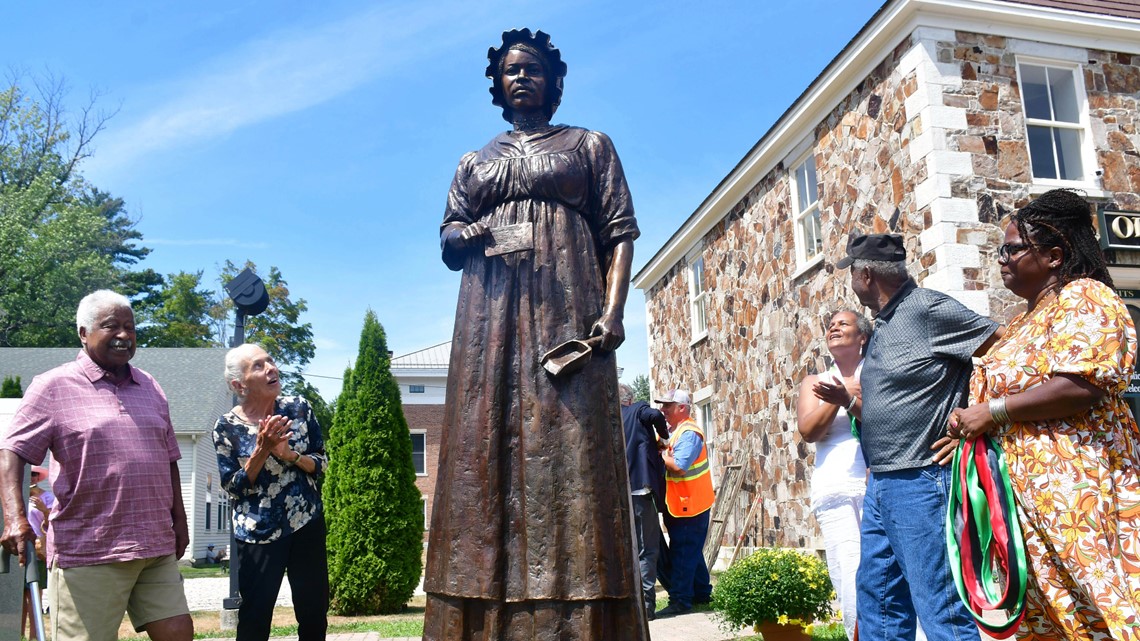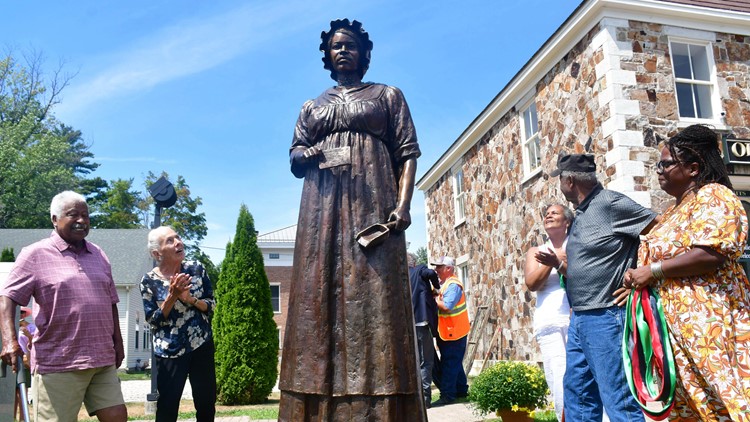WASHINGTON — The story of an enslaved woman who went to court to win her freedom more than 80 years before the Emancipation Proclamation had been pushed to the fringes of history.
A group of civic leaders, activists and historians hope that ended Sunday in the quiet Massachusetts town of Sheffield with the unveiling of a bronze statue of the woman who chose the name Elizabeth Freeman when she shed the chains of slavery 241 years ago to the day.
Her story, while remarkable, remains relatively obscure.
State Rep. William “Smitty” Pignatelli grew up not far from Sheffield in the Berkshires of western Massahusetts yet didn't hear her story until about 20 years ago. He found that many of his colleagues in the Statehouse were also largely in the dark about the significance of her case, which set the legal precedent that essentially ended slavery in Massachusetts.


“She’s clearly a hidden figure in American history, and I really believe Black history is American history,” said Pignatelli, a Democrat. “But unfortunately, Black history is what we haven’t been told and taught.”
The enslaved woman, known as Bett, could not read or write, but she listened.
And what she heard did not make sense.
While she toiled in bondage in the household of Col. John Ashley, he and other prominent citizens of Sheffield met to discuss their grievances about British tyranny. In 1773, they wrote in what are known as the Sheffield Resolves that “Mankind in a state of nature are equal, free, and independent of each other."
Those words were echoed in Article 1 of the Massachusetts Constitution in 1780, which begins “All men are born free and equal, and have certain natural, essential, and unalienable rights.”
It is believed that Bett, after hearing a public reading of the constitution, walked roughly 5 miles from the Ashley household to the home of attorney Theodore Sedgwick, one of the citizens who drafted the Sheffield Resolves, and asked him to represent her in her legal quest for freedom, said Paul O’Brien, president of the Sheffield Historical Society.
Sedgwick and another attorney, Tapping Reeve, took the case.
Women had limited legal rights in Massachusetts courts at the time, so a male slave in the Ashley household named Brom was added to the case.
The jury agreed with the attorneys, freeing Bett and Brom on Aug. 21, 1781.
Former Massachusetts Gov. Deval Patrick, and his wife, Diane, are residents of the Berkshires and have been instrumental in fundraising and organizational efforts. They led Sunday’s ceremony.
“What I love about the story is that this remarkable woman, enslaved, sometimes brutalized, unable to read, listened carefully to the conversation around the table as the men she was serving discussed the concepts of life, liberty and the pursuit of happiness as ‘inalienable rights,'" Patrick, the state's first Black governor, said in an email. “I love that this powerless woman could imagine these powerful ideas as her own, and could persuade others to test that question. And I love that the Massachusetts courts had the integrity of purpose to take her question seriously.”
Pignatelli was inspired to raise a statue of Freeman last year when he attended the unveiling of a statue of Susan B. Anthony in Adams, the Berkshire County community where the suffragist was born.
He brought together stakeholders and raised about $280,000, enough money for the roughly 8-foot statue, as well as a scholarship fund in Freeman's honor for area high school students.
Gwendolyn VanSant, the CEO of BRIDGE, an area nonprofit that fosters racial understanding and equity, is overseeing the scholarships.
She called Freeman an icon and a trailblazer. “For me as an African American woman, it's amazing to be walking in her footsteps,” she said.
After the court case, Ashley asked Freeman to return to his household as a paid servant, but she refused and instead went to work for Sedgwick, where she helped raise his children and was known by the affectionate name, Mumbet.
She was a healer, a nurse and a midwife, who bought her own property in nearby Stockbridge, VanSant said.
The Sedgwicks had such a deep respect for Mumbet that when she died in 1829 at about the age of 85 she was buried with them, the only non-family member in the family plot. Much of what historians know about her was written by one of Theodore Sedgwick’s daughters, the novelist Catharine Maria Sedgwick, O'Brien said.
The statue, cast by renowned sculptor Brian Hanlon, was placed on the property of the First Congregational Church in Sheffield, not far from the Sedgwick home.
“We don’t know if Elizabeth Freeman went to the church, but we know Ashley did, and it was common for enslavers to bring enslaved people to look after their children at church," said O'Brien.
Although some 200 people were expected to attend Sunday's unveiling, the culmination of three days of celebrations, organizers have been unable to find any of Freeman's descendants.
VanSant hopes a permanent memorial will spur interest into Freeman's story. “Maybe her descendants will find us,” she said.


